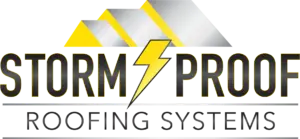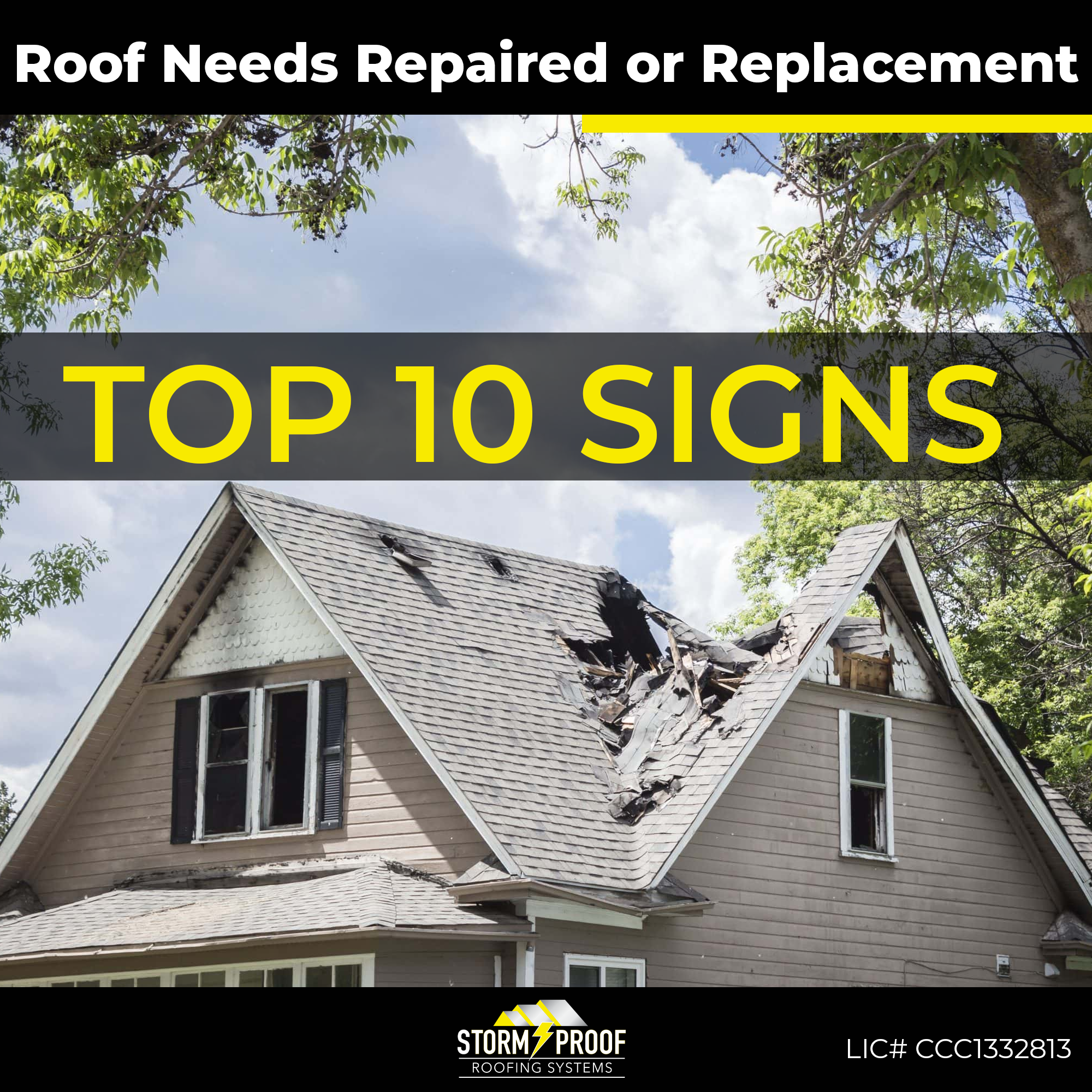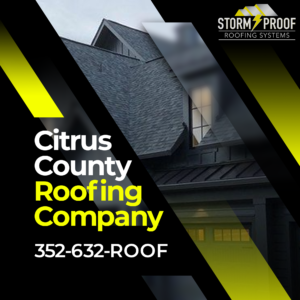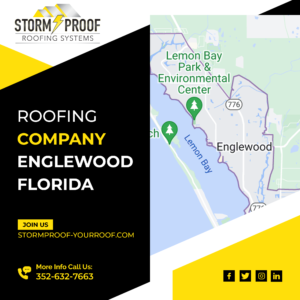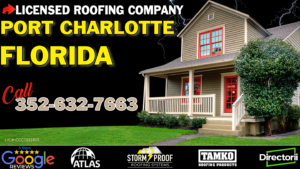A roof is one of the most critical components of a building, providing protection from weather elements and keeping the occupants safe and comfortable. However, it is also one of the most overlooked parts of a building. Many property owners only consider their roof when they experience a problem, which can result in costly repairs or even a complete replacement. In this blog post, we will outline the top 10 signs that your roof needs repair or replacement, so you can be proactive and avoid expensive repairs down the road.
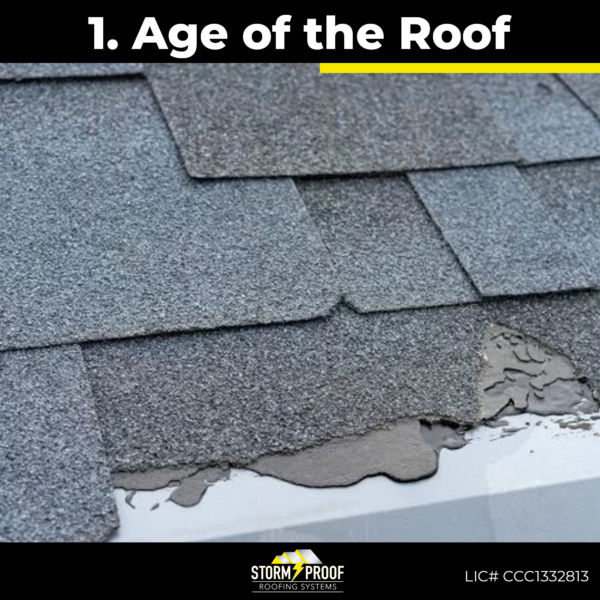
1. Age of the Roof
If your roof is over 20 years old, it’s likely time for a replacement. Roofs have a lifespan, and beyond this point, they become less effective at protecting your property. If you are unsure about the age of your roof, you can consult with a professional roofing contractor.
Your roof is a vital component of your home, protecting you and your family from the elements. As your roof ages, it becomes more susceptible to wear and tear, potentially compromising its effectiveness. Understanding the age of your roof is crucial in ensuring its continued functionality.
Commonly, roofs have a lifespan of 15-25 years, depending on the material and quality of installation. However, factors such as weather conditions, maintenance, and ventilation can impact the longevity of your roof. Neglecting the age of your roof can lead to significant issues, such as water leaks, mold growth, and increased energy bills.
Ignoring the age of your roof can also lead to emotional distress, such as anxiety, fear, and frustration. The idea of needing a roof replacement can be overwhelming, and the cost can cause financial stress. However, taking proactive measures, such as regular inspections and maintenance, can prolong the life of your roof and alleviate these emotions.
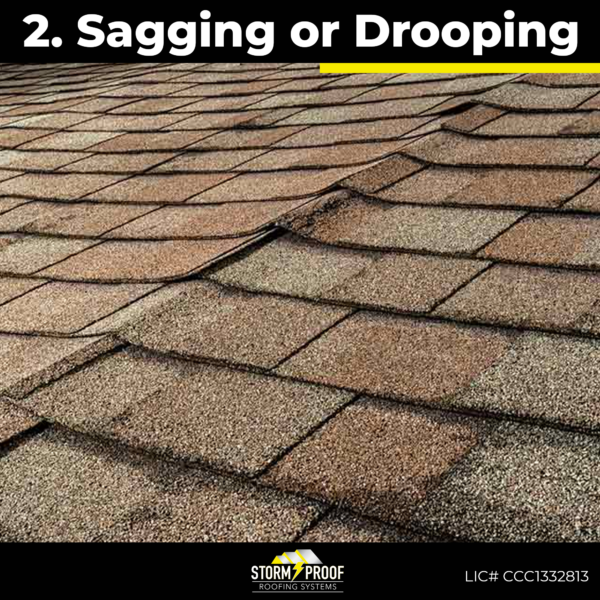
2. Sagging or Drooping
If you notice your roof is sagging or drooping, this is a sign of a structural issue. It could be due to a damaged foundation or water damage, and it’s essential to get it inspected immediately. A sagging or drooping roof could collapse and put the occupants at risk.
Sagging or drooping of a roof can be a sign of significant structural damage and should not be ignored. Common causes of roof sagging include age, poor installation, excessive weight from snow or debris, and water damage.
If left untreated, sagging or drooping can lead to severe issues, such as a collapse of the roof, water leaks, and mold growth. Additionally, the emotional toll of dealing with such damage can be overwhelming, leading to anxiety, fear, and frustration.
Addressing sagging or drooping requires immediate action. Hiring a qualified roofing professional to assess the damage and provide solutions is essential. The solution may include repairs or even a full roof replacement, depending on the severity of the damage.
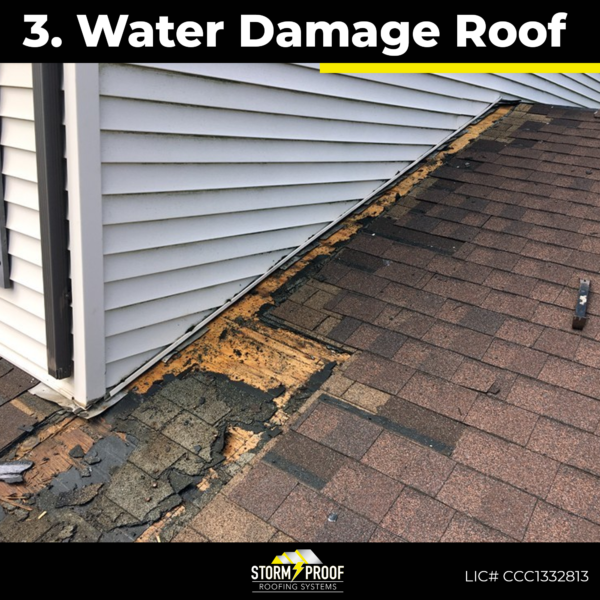
3. Water Damage
Water damage is a clear sign that your roof needs attention. If you notice water stains or mold growth on your ceiling, it could be due to a leak in your roof. It’s crucial to address this issue promptly, as water damage can quickly spread and cause further structural damage.
If left untreated, water damage can lead to significant structural issues, as well as health hazards from mold growth. The emotional impact of dealing with water damage can be overwhelming, leading to feelings of anxiety, stress, and frustration.
To address water damage, it is essential to hire a qualified roofing professional to assess the damage and provide solutions. Depending on the severity of the damage, repairs may be necessary, such as fixing flashing or replacing damaged shingles. In more severe cases, a full roof replacement may be required.
Ignoring water damage can be costly and emotionally draining, impacting the safety and protection of your home and loved ones. It is crucial to take prompt action to mitigate the damage and prevent further issues from occurring. Contacting a qualified roofing professional as soon as possible is key to addressing any potential water damage and restoring the integrity of your roof.
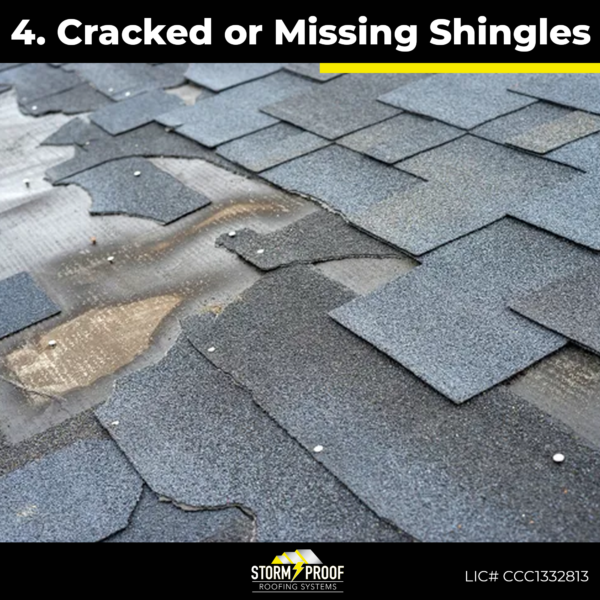
4. Cracked or Missing Shingles
Shingles play a vital role in protecting your roof from weather elements, and if they are cracked or missing, it can lead to further damage. If you notice cracked or missing shingles, it’s time to consider a repair or replacement.
Cracked or missing shingles are a common problem that homeowners may face. Shingles are the outermost layer of a roof and protect the roof from weather elements such as rain, wind, snow, and sunlight. When shingles crack or become missing, they expose the underlying roof to these elements, potentially causing leaks and other forms of damage.
Several factors can cause shingles to crack or become missing. One of the most common causes is aging. As shingles age, they become brittle and more susceptible to cracking or breaking. Additionally, exposure to harsh weather conditions can cause shingles to deteriorate more quickly.
Another cause of cracked or missing shingles is improper installation. If shingles are not installed correctly, they may not be able to withstand strong winds or other weather elements, which can cause them to crack or become dislodged. Similarly, if shingles are not nailed down properly, they may come loose and fall off the roof.
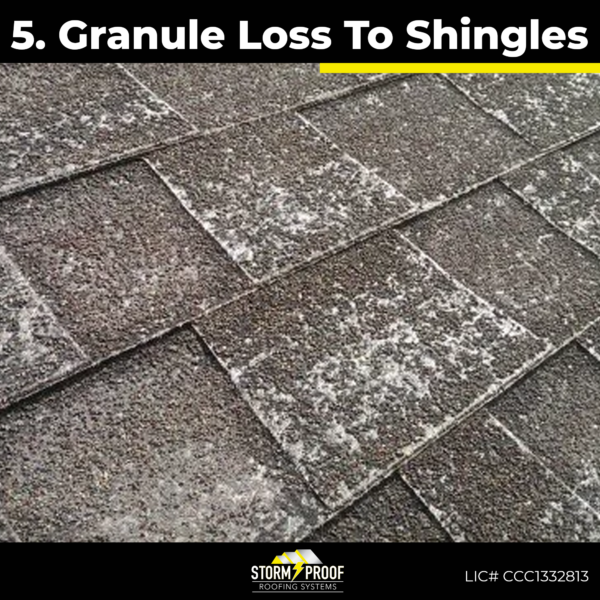
5. Granule Loss
Granules on your shingles protect your roof from the sun’s UV rays and other weather elements. If you notice granules accumulating in your gutters or missing from your shingles, it’s a sign that your roof needs attention.
Granule loss is a common issue that can occur with asphalt shingles, which are a popular roofing material used in many homes. The granules on asphalt shingles serve several important purposes, including protecting the shingles from UV rays and providing aesthetic appeal. Granules can become dislodged or eroded over time, leading to granule loss.
There are several factors that can contribute to granule loss on asphalt shingles. One of the most common is aging. As shingles age, the granules can become loose and begin to fall off. Additionally, exposure to harsh weather elements such as hail, heavy rain, and strong winds can cause the granules to become dislodged or eroded more quickly.
Another cause of granule loss can be improper installation or poor quality shingles. If shingles are not installed correctly, they may not be able to withstand the elements, leading to premature granule loss. Similarly, if the shingles are of low quality, the granules may not be properly adhered to the shingle, making them more likely to come off.
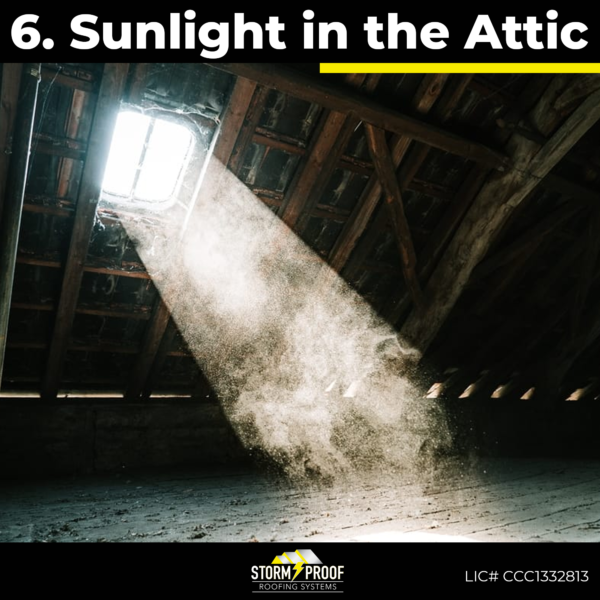
6. Sunlight in the Attic
If you notice sunlight coming through your attic, it’s a sign that your roof has holes or cracks that need attention. Sunlight can cause further damage to your property and also let in water and pests.
There are several causes of sunlight in the attic due to a bad roof. One of the most common is missing or damaged shingles. Shingles are the outermost layer of a roof and protect the underlying structure from the elements. If shingles are missing or damaged, sunlight can easily pass through the gaps, exposing the attic to harmful UV rays and other weather conditions.
Another cause of sunlight in the attic can be damaged flashing or sealant. Flashing is the metal or plastic material that is installed around roof penetrations such as chimneys or vents. If the flashing is damaged or missing, sunlight can enter the attic through the gaps. Similarly, if the sealant around the flashing or other roof penetrations has deteriorated, sunlight can enter through these gaps as well.
Sunlight in the attic due to a bad roof can lead to several problems. The most obvious is that it can increase the temperature in the attic, making it harder to regulate the temperature in your home and potentially leading to increased energy costs. Additionally, sunlight can damage insulation and other materials in the attic, leading to mold growth and other forms of damage.

7. Higher Energy Bills
If you notice a sudden increase in your energy bills, it could be due to a problem with your roof. A damaged roof can cause air leaks, which can make it harder to regulate the temperature in your property and increase your energy bills.
Higher energy bills can be a result of having a bad roof. If your roof has not been properly maintained, it may be allowing air to escape from your home, resulting in higher energy bills.
A poor roof can also allow water to leak through, causing mold and mildew to form inside the home, which can increase the humidity and make it harder to keep your home cool. Additionally, any insulation in the attic may become damaged over time, leading to further energy losses.
In order to combat higher energy bills due to a bad roof, it‘s important to maintain regular roof inspections. This will allow any potential problems to be identified and fixed before they cause too much damage to your home. Additionally, proper insulation should be installed in the attic to help keep your home cooler and reduce energy bills.

8. Animal Damage
Animals can cause damage to your roof, from nesting and scratching to chewing through shingles. If you notice any signs of animal damage, it’s essential to get it repaired promptly to avoid further damage.
In order to prevent animal damage to roofs, homeowners should take a few steps. Firstly, they should inspect their roofs regularly to identify any signs of damage. If they notice any holes or other signs of damage, they should immediately contact a professional to repair the damage.
Additionally, homeowners should consider installing screens or covers over their vents and chimneys to prevent animals from entering them. They should also make sure to keep any trees and shrubs near the house trimmed to discourage animals from nesting in them.
Finally, homeowners should consider installing a metal roof or one made of a material like asphalt shingles, which are more resistant to animal damage.
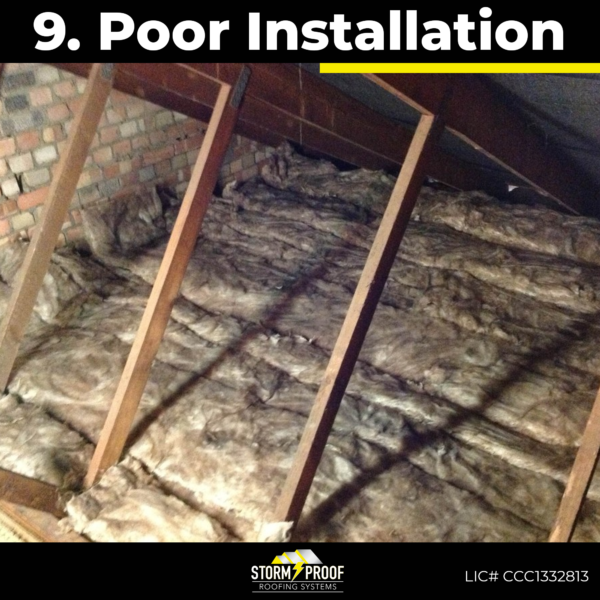
9. Poor Installation
If your roof was not installed correctly, it can lead to problems down the road. Signs of poor installation include misaligned shingles, uneven lines, and sagging sections. If you notice any of these signs, it’s time to get your roof inspected by a professional.
Poorly installed roofs can be a major source of problems for homeowners. If a roof is not installed correctly, it can lead to water damage, leaks, and other issues. These problems can be costly to repair and can result in higher energy bills.
In order to avoid these problems, it’s important to make sure that the roof is installed correctly the first time. This means hiring a professional roofer who has experience with the type of roof you are installing and who can properly install it. It’s also important to make sure that the roof is installed using the correct materials and techniques.
In addition to hiring a professional, homeowners should also make sure to inspect the roof regularly. This will help identify any potential problems before they become too serious. Additionally, it’s important to make sure that the roof is properly ventilated to reduce the risk of moisture buildup and mold.
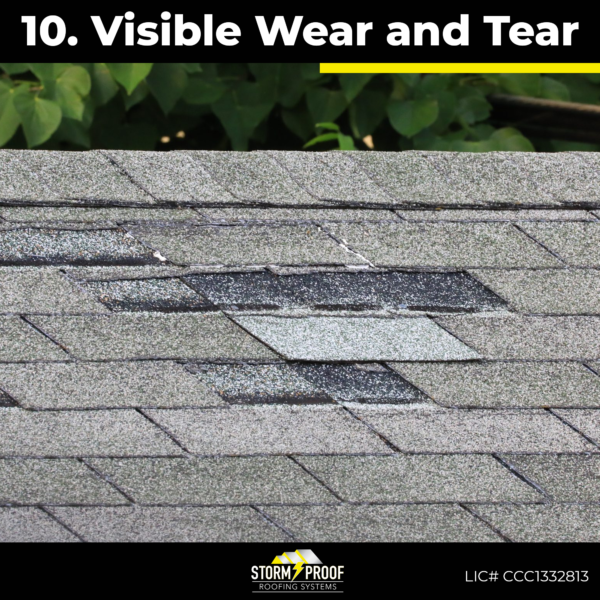
10. Visible Wear and Tear
Visible wear and tear on a roof can indicate potential issues that require attention and repair. Wear and tear can manifest in various forms, including missing or cracked shingles, curled edges, granule loss, and discoloration. These signs can be caused by various factors, such as age, weather conditions, poor installation, or lack of maintenance.
If left unaddressed, wear and tear can lead to more severe problems, such as water leaks, mold growth, and energy loss. It can also compromise the structural integrity of the roof, making it more susceptible to damage from strong winds or heavy rain.
In order to address visible wear and tear on roof, it’s important to have a professional roofer inspect the roof. They can identify the cause of the wear and recommend the best way to repair it. This may include replacing or repairing damaged shingles, adding additional flashing, or replacing damaged insulation.
It’s also important to inspect the roof regularly to identify any additional wear and tear. This can help prevent potential issues from becoming more serious. Additionally, regular inspections can help identify any potential problems before they become too costly to repair.
